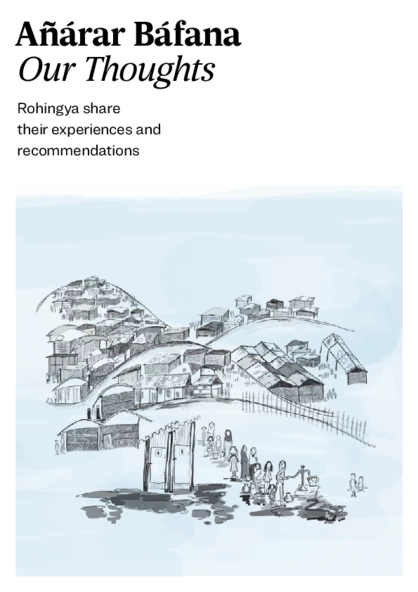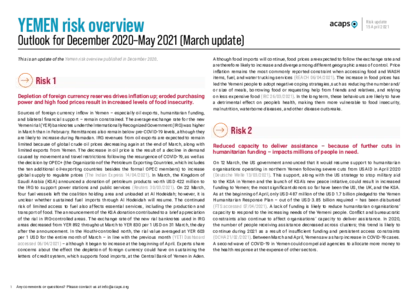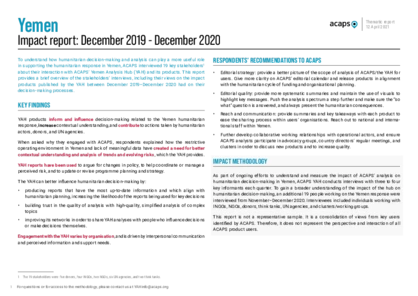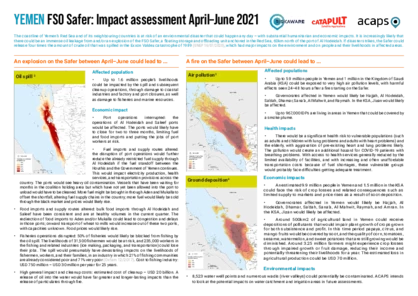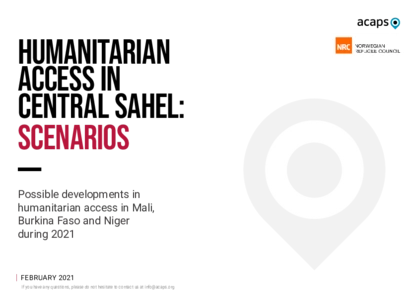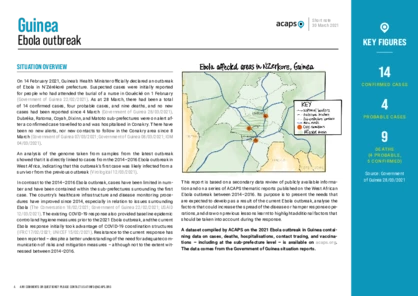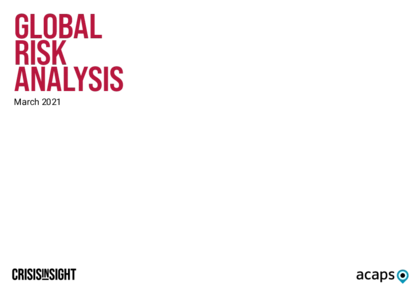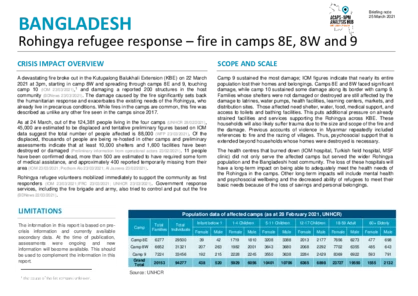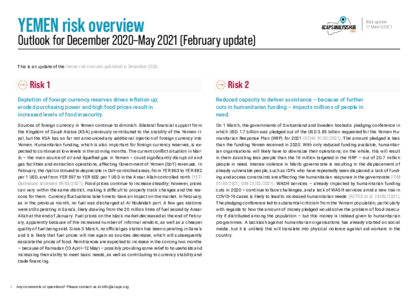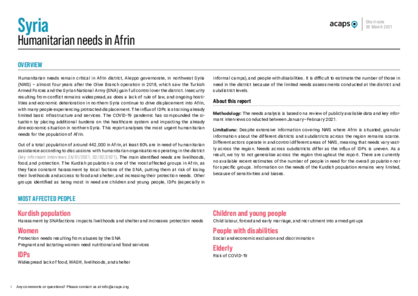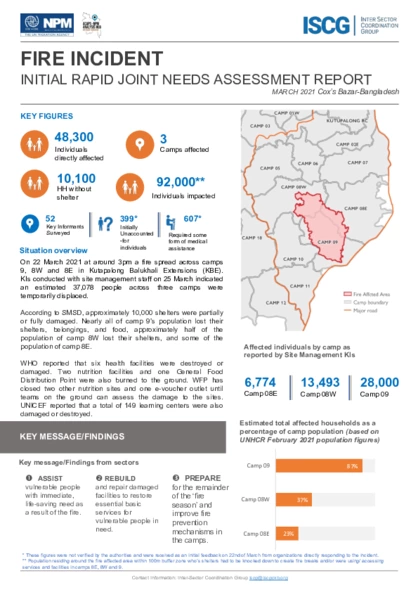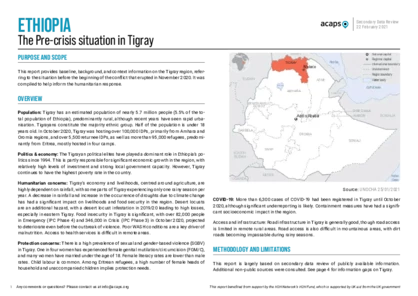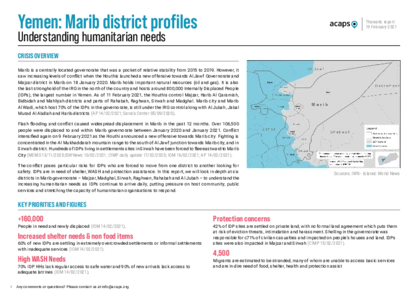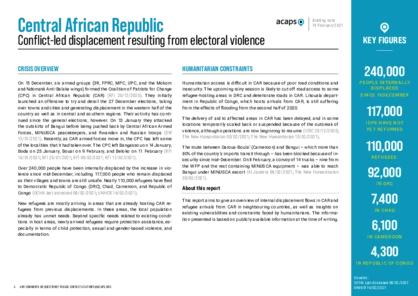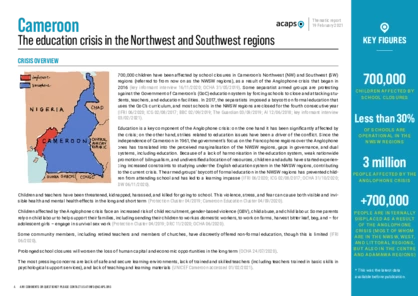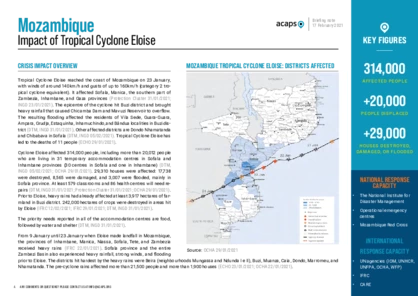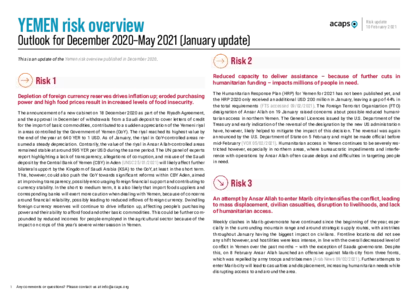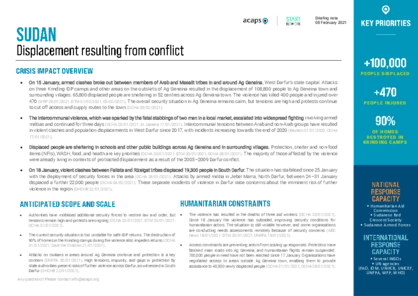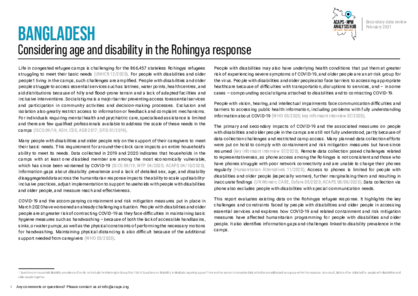Explore our
analysis products
archive
22 April 2021
Our thoughts: Rohingya share their experiences and recommendations
DOCUMENT / PDF / 10 MB
This report by ACAPS and IOM's Communicating with Communities unit is a large qualitative study exploring how Rohingya refugees have experienced the humanitarian response in Cox's Bazar, with a focus on accountability within the response. It explores recurrent themes within the response and concludes with recommendations from the participants for different sectors within the response.
Attached resources
15 April 2021
Yemen: Outlook for December 2020 - May 2021
DOCUMENT / PDF / 287 KB
ACAPS has developed a risk-monitoring framework which is updated daily with significant events. Every month, ACAPS analysts and technical experts, including economists and anthropologists, review the current development of indicators collectively and update the risk outlook. This is an update of the Yemen risk overview published in December 2020.
12 April 2021
Yemen: Impact review from December 2019 - December 2020
DOCUMENT / PDF / 238 KB
This report provides a brief overview of the stakeholders’ interviews, including their views on the impact products published by the YAH between December 2019–December 2020 had on their decision-making processes.
07 April 2021
Yemen: FSO Safer impact assessment April-June 2021
DOCUMENT / PDF / 293 KB
The coastline of Yemen’s Red Sea and of its neighbouring countries is at risk of an environmental disaster that could happen any day – with substantial humanitarian and economic impacts. It is increasingly likely that there could be an immense oil leakage from and/or an explosion of the FSO Safer, a floating storage and offloading unit anchored in the Red Sea, 60km north of the port of Al Hodeidah.
Attached resources
31 March 2021
Scenarios: Humanitarian access in Central Sahel
DOCUMENT / PDF / 1 MB
Possible developments in humanitarian access in Mali, Burkina Faso and Niger during 2021.
Attached resources
30 March 2021
Guinea: Ebola outbreak
DOCUMENT / PDF / 1 MB
This report presents the needs that are expected to develop as a result of the current Ebola outbreak, analyse the factors that could increase the spread of the disease or hamper response operations, and draw on previous lessons learnt to highlight additional factors that should be taken into account during the response.
26 March 2021
Bangladesh: Fire in Rohingya refugee camps 8E, 8W and 9
DOCUMENT / PDF / 912 KB
This briefing note reports on a devastating fire that broke out in the Kutupalong Balukhali Extension (KBE) on 22 March 2021 at 3pm. The damage caused by the fire significantly sets back the humanitarian response and exacerbates the existing needs of the Rohingya, who already live in precarious conditions.
11 March 2021
Yemen: Outlook for Dec 2020 - May 2021 (February update)
DOCUMENT / PDF / 259 KB
ACAPS’ Yemen Analysis Hub has developed a risk-monitoring framework which is updated daily with significant events. Every month, ACAPS analysts and technical experts, including economists and anthropologists, review the current development of indicators collectively and update the risk outlook. This is an update of the Yemen risk overview published in December 2020.
07 March 2021
Scenarios: Post-COVID-19
DOCUMENT / PDF / 594 KB
These scenarios focus primarily on the potential ways the global humanitarian situation may change over 2021, although they are anticipated to remain valid well into 2022. It should be noted that the scenarios are not mutually exclusive. Because the focus is global, it is possible for one scenario to transpire in one region or country while the other scenarios may develop elsewhere.
03 March 2021
Syria: Humanitarian needs in Afrin
DOCUMENT / PDF / 419 KB
Humanitarian needs remain critical in Afrin district, Aleppo governorate, in northwest Syria (NWS) – almost four years after the Olive Branch operation in 2018, which saw the Turkish Armed Forces and the Syrian National Army gain full control over the district. This report analyses the most urgent humanitarian needs for the population of Afrin.
01 March 2021
Rohingya crisis: Fire incident
DOCUMENT / PDF / 672 KB
Initial rapid joint needs assessment report
According to SMSD, approximately 10,000 shelters were partially or fully damaged. Nearly all of camp 9’s population lost their shelters, belongings, and food, approximately half of the population of camp 8W lost their shelters, and some of the population of camp 8E.
22 February 2021
Ethiopia: Pre-crisis situation in Tigray
DOCUMENT / PDF / 2 MB
This report provides baseline, background, and context information on the Tigray region, referring to the situation before the beginning of the conflict that erupted in November 2020. It was compiled to help inform the humanitarian response.
19 February 2021
Yemen: Marib District Profile
DOCUMENT / PDF / 819 KB
Marib is a centrally located governorate that was a pocket of relative stability from 2015 to 2019. However, it saw increasing levels of conflict when the Houthis launched a new offensive towards Al Jawf Governorate and Majzar district on 18 January 2020.
Attached resources
19 February 2021
CAR: Displacement resulting from electoral violence
DOCUMENT / PDF / 290 KB
This report aims to give an overview of internal displacement flows in CAR and refugee arrivals from CAR in neighbouring countries, as well as insights on existing vulnerabilities and constraints faced by humanitarians. The information presented is based on publicly available information at the time of writing.
19 February 2021
Cameroon: Education crisis in North West and South West regions
DOCUMENT / PDF / 2 MB
This report consolidates information from a wide range of available secondary data sources on the Anglophone crisis in Cameroon, including UN agencies, NGOs, the World Bank, media, and key informant interviews conducted in November 2020 and February 2021. Prior to publication, the report was shared with external partners working in Cameroon to cross-check information.
Attached resources
17 February 2021
Mozambique: Tropical Cyclone Eloise
DOCUMENT / PDF / 253 KB
Tropical Cyclone Eloise reached the coast of Mozambique on 23 January. It affected Sofala, Manica, the southern part of Zambezia, Inhambane, and Gaza provinces. About 314,000 people have been affected, including more than 20,000 people who are living in 31 temporary accommodation centres in Sofala and Inhambane provinces.
10 February 2021
Yemen: Outlook for Dec 2020 - May 2021 (January update)
DOCUMENT / PDF / 290 KB
ACAPS has developed a risk-monitoring framework which is updated daily with significant events. Every month, ACAPS analysts and technical experts, including economists and anthropologists, review the current development of indicators collectively and update the risk outlook. This is an update of the Yemen risk overview published in December 2020.
08 February 2021
Sudan: Displacement resulting from conflict
DOCUMENT / PDF / 381 KB
On 15 January, armed clashes broke out in and around Ag Geneina, West Darfur’s state capital. Attacks on three Krinding IDP camps and other areas on the outskirts of Ag Geneina resulted in the displacement of 108,800 people to Ag Geneina town and surrounding villages.
08 February 2021
Considering age and disability in the Rohingya response
DOCUMENT / PDF / 309 KB
This report highlights the challenging life in congested refugee camps for over 866,000 stateless Rohingya refugees struggling to meet their basic needs. For people with disabilities and older people living in the camps, such challenges are amplified.


